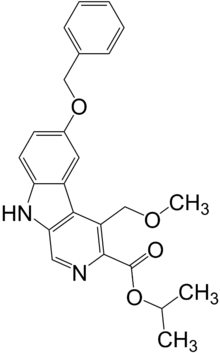阿貝卡爾
化合物
阿貝卡爾(英語:Abecarnil,代號:ZK-112,119)是一種來自β-咔啉家族的抗焦慮藥。它是相對較新開發的一類藥物之一,稱為非苯二氮䓬類藥物,與較早的苯二氮䓬類藥物具有相似的作用,但化學結構截然不同。它是一種部分激動劑,選擇性地作用於GABAA受體的苯二氮䓬位點。[1]
 | |
| 臨床資料 | |
|---|---|
| ATC碼 |
|
| 藥物動力學數據 | |
| 生物半衰期 | 3.4 hours (IV), 7 hours (oral) |
| 識別資訊 | |
| |
| CAS編號 | 111841-85-1 |
| PubChem CID | |
| ChemSpider | |
| UNII | |
| KEGG | |
| ChEMBL | |
| CompTox Dashboard (EPA) | |
| 化學資訊 | |
| 化學式 | C24H24N2O4 |
| 摩爾質量 | 404.47 g·mol−1 |
| 3D模型(JSmol) | |
| |
| |
阿貝卡爾最初是作為抗焦慮藥物開發的,但尚未商業化開發用於人類,目前主要用於研究開發其他新型鎮靜和抗焦慮藥物。對其作用的調查仍在繼續,它看起來很可能被開發用於治療焦慮症,[2]以及作為一種不太容易上癮的替代藥物來治療苯二氮䓬類藥物[3]和酒精[4]成癮。與非選擇性全激動劑苯二氮䓬類藥物相比,阿貝卡尼的耐受性和戒斷問題也可能更少。[5]
阿貝卡爾是一種相對亞型選擇性的藥物,主要產生抗焦慮作用,具有相對較弱的鎮靜或肌肉鬆弛作用,[6][7]並且不會顯着增強酒精的作用。[8]
參見
編輯參考資料
編輯- ^ Ozawa, M; Nakada, Y; Sugimachi, K; Yabuuchi, F; Akai, T; Mizuta, E; Kuno, S; Yamaguchi, M. Pharmacological characterization of the novel anxiolytic beta-carboline abecarnil in rodents and primates. Japanese Journal of Pharmacology. Mar 1994, 64 (3): 179–87. PMID 7912751. doi:10.1254/jjp.64.179 .
- ^ Aufdembrinke B. Abecarnil, a new beta-carboline, in the treatment of anxiety disorders. British Journal of Psychiatry. 1998, 34 (34): 55–63. PMID 9829018. S2CID 24311570. doi:10.1192/S0007125000293537.
- ^ Pinna G, Galici R, Schneider HH, Stephens DN, Turski L. Alprazolam dependence prevented by substituting with the beta-carboline abecarnil. Proceedings of the National Academy of Sciences of the United States of America. Mar 1997, 94 (6): 2719–23. Bibcode:1997PNAS...94.2719P. PMC 20156 . PMID 9122263. doi:10.1073/pnas.94.6.2719 .
- ^ Jung ME, Wallis CJ, Gatch MB, Lal H. Abecarnil and alprazolam reverse anxiety-like behaviors induced by ethanol withdrawal. Alcohol. Jun 2000, 21 (2): 161–8. PMID 10963939. doi:10.1016/S0741-8329(00)00079-3.
- ^ Löscher W, Hönack D. Withdrawal precipitation by benzodiazepine receptor antagonists in dogs chronically treated with diazepam or the novel anxiolytic and anticonvulsant beta-carboline abecarnil. Naunyn Schmiedebergs Arch. Pharmacol. April 1992, 345 (4): 452–60. PMID 1352384. S2CID 20486955. doi:10.1007/BF00176624.
- ^ Krause W, Schutt B, Duka T. Pharmacokinetics and acute toleration of the beta-carboline derivative abecarnil in man. Arzneimittelforschung. May 1990, 40 (5): 529–32. PMID 1974428.
- ^ Duka T, Schutt B, Krause W, Dorow R, McDonald S, Fichte K. Human studies on abecarnil, a new beta-carboline anxiolytic: safety, tolerability and preliminary pharmacological profile. British Journal of Clinical Pharmacology. Apr 1993, 35 (4): 386–94. PMC 1381549 . PMID 8097921. doi:10.1111/j.1365-2125.1993.tb04155.x.
- ^ Stephens DN, Schneider HH, Kehr W, Andrews JS, Rettig KJ, Turski L, Schmiechen R, Turner JD, Jensen LH, et al. Abecarnil, a metabolically stable, anxioselective beta-carboline acting at benzodiazepine receptors. Journal of Pharmacology and Experimental Therapeutics. Apr 1990, 253 (1): 334–43. PMID 1970361.
- ^ Sannerud CA, Ator NA, Griffiths RR. Behavioral pharmacology of abecarnil in baboons: self-injection, drug discrimination and physical dependence. Behavioural Pharmacology. Oct 1992, 3 (5): 507–516. PMID 11224153. S2CID 32081258. doi:10.1097/00008877-199210000-00009.
- ^ Ballenger JC, McDonald S, Noyes R, Rickels K, Sussman N, Woods S, Patin J, Singer J. The first double-blind, placebo-controlled trial of a partial benzodiazepine agonist abecarnil (ZK 112-119) in generalized anxiety disorder. Psychopharmacology Bulletin. 1991, 27 (2): 171–9. PMID 1681563.